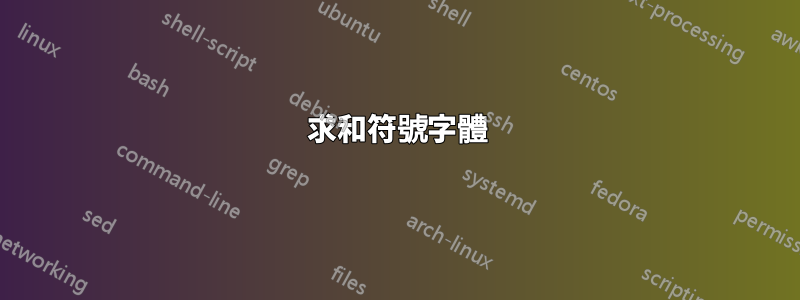
答案1
更新1:2024/05/03
此\sum符號取自 pakage txfonts(或您可以取自Libertinus Math):請參閱圖中的簡短 MWE 和 。
%% Compile and read me!
\documentclass[a4paper,12pt]{article}
\usepackage{txfonts}
\usepackage[T1]{fontenc}
\begin{document}
\[\sum^{n}_{i=1}{xcv}\]
\end{document}
使用引擎XeLaTeX:以我的拙見,\sum給出了非常接近的符號STIX 兩個數學。我也嘗試過Cambria Math(請參閱第二個代碼),但它很大:但可以用scalerel包垂直拉伸符號(我沒有嘗試過)。如果你知道常用字體,就取消STIX Two Math並輸入字體名稱。
\documentclass[12pt]{article}
\usepackage{unicode-math}
\setmathfont{Latin Modern Math}
\setmathfont[range={\sum}, Scale=MatchUppercase]{STIX Two Math}
\let\mathbb\relax % remove the definition by unicode-math
\DeclareMathAlphabet{\mathbb}{U}{msb}{m}{n}
\begin{document}
The range of matrix $A\in\mathbb{K}^{I\times J}$ is
\[
\operatorname{range}(A)=\{Ax\colon x\in\mathbb{K}^{J}\}=\operatorname{span}\{A_{(j)},i\in J\}.
\]
Hence, the range of a matrix is a vector space spanned by its columns. The Euclidean scalar product in $\mathbb{K}^I$ is given by.
\[\langle x,y\rangle=y^Hx=\sum_{i\in I}x_i\bar{y}_i,\]
where for $\mathbb{K}=\mathbb{R}$ the conjugate sign can be ignored. It is often useful and very
\end{document}
或使用 Cambria Math:
\documentclass[12pt]{article}
\usepackage{unicode-math}
\setmathfont{Latin Modern Math}
\setmathfont[range={\sum}, Scale=MatchUppercase]{Cambria Math}
\let\mathbb\relax % remove the definition by unicode-math
\DeclareMathAlphabet{\mathbb}{U}{msb}{m}{n}
\begin{document}
The range of matrix $A\in\mathbb{K}^{I\times J}$ is
\[
\operatorname{range}(A)=\{Ax\colon x\in\mathbb{K}^{J}\}=\operatorname{span}\{A_{(j)},i\in J\}.
\]
Hence, the range of a matrix is a vector space spanned by its columns. The Euclidean scalar product in $\mathbb{K}^I$ is given by.
\[\langle x,y\rangle=y^Hx=\sum_{i\in I}x_i\bar{y}_i,\]
where for $\mathbb{K}=\mathbb{R}$ the conjugate sign can be ignored. It is often useful and very
\end{document}
你還可以看到這個TeX Gyre Pagella Math(很好):
\documentclass[12pt]{article}
\usepackage{unicode-math}
\setmathfont{Latin Modern Math}
\setmathfont[range={\sum}, Scale=MatchUppercase]{TeX Gyre Pagella Math}
\let\mathbb\relax % remove the definition by unicode-math
\DeclareMathAlphabet{\mathbb}{U}{msb}{m}{n}
\begin{document}
The range of matrix $A\in\mathbb{K}^{I\times J}$ is
\[
\operatorname{range}(A)=\{Ax\colon x\in\mathbb{K}^{J}\}=\operatorname{span}\{A_{(j)},i\in J\}.
\]
Hence, the range of a matrix is a vector space spanned by its colunns. The Euclidean scalar product in $\mathbb{K}^I$ is given by.
\[\langle x,y\rangle=y^Hx=\sum_{i\in I}x_i\bar{y}_i,\]
where for $\mathbb{K}=\mathbb{R}$ the conjugate sign can be ignored. It is often useful and very
\end{document}
有TeX Gyre Termes Math良好的):








